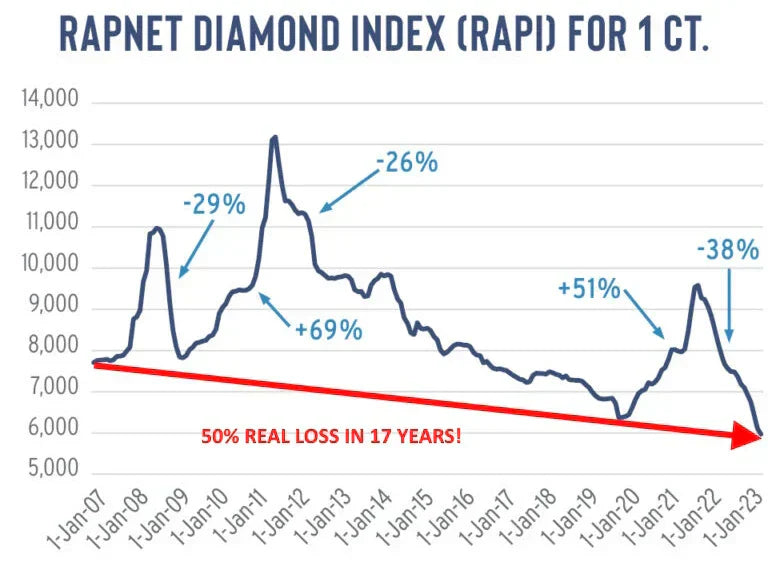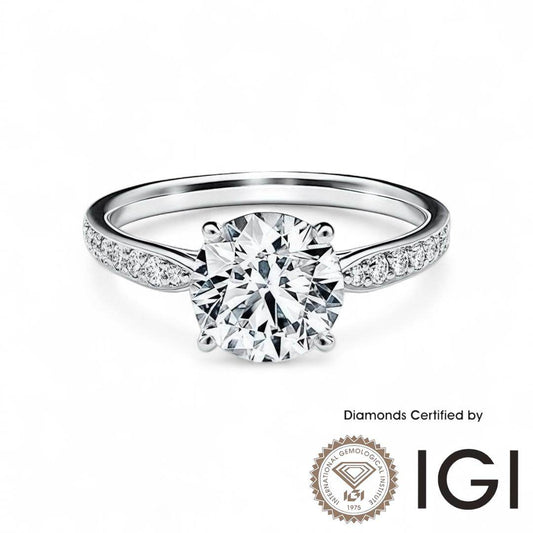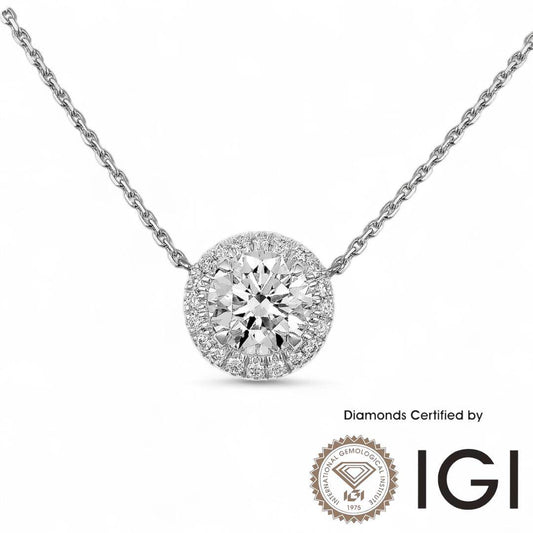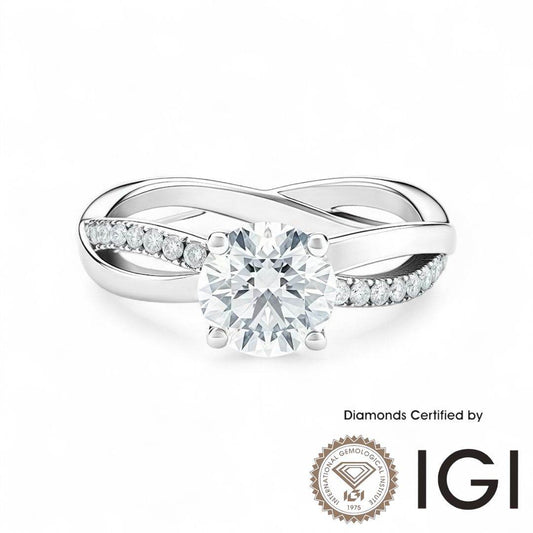Why You Should Choose Lab-Grown Diamonds Over Natural Diamonds
Why You Should Buy a Lab-Grown Diamond Instead of a Natural Diamond (2025)
A data-driven, practical guide for modern buyers: why natural diamonds no longer function as reliable investments, and why lab-grown diamonds offer better value, ethics, and everyday wearability.
Executive Summary
Over the last decade (2015–2025) the global natural diamond market has changed materially. Industry price indices and authoritative reports show that average wholesale prices for quality natural diamonds (1.0 ct, top color/clarity) have declined materially—by a large single-digit to mid-double-digit percentage depending on the specific segment and index used. Simultaneously, lab-grown diamond production cost and retail prices have collapsed, making lab-grown stones an accessible, high-quality alternative.
This article pulls together market trends, price comparisons (converted to HKD for consistency, with USD equivalents), and lifestyle reasoning to support one practical conclusion for modern buyers: if your objective is beautiful jewelry you can wear and enjoy, rather than an appreciation investment, a lab-grown diamond is now the smarter choice.
1. Natural Diamond Price Trend (2015–2025): What the Data Shows
Multiple industry sources—Rapaport, De Beers/Bain reports, IDEX and independent financial press—have documented a downtrend in many natural diamond price segments since the mid-2010s. The top-end market (flawless, D-color, ideal cut) is more resilient, but the broad market for 1ct stones and the mainstream retail segments have experienced meaningful price pressure.
Representative price table (illustrative / synthesis)
Important: the table below is a synthesized, representative index intended to show the order of magnitude of the market change for a 1.0-carat, top-quality natural diamond (D color, VVS2, excellent cut). It combines publicly reported trends and industry commentary; if you require live, subscription-level Rapaport or De Beers pricing, replace the row values with your licensed figures.
| Year | Representative Avg Wholesale Price (HKD per 1.0 ct, D/VVS2/excellent) | USD Equivalent (approx.) | Comment |
|---|---|---|---|
| 2015 | HKD 98,000 | ≈ USD 12,564 | Peak years before broader lab-grown competition |
| 2017 | HKD 92,500 | ≈ USD 11,859 | early signs of pressure; lab demand starts |
| 2019 | HKD 86,000 | ≈ USD 11,026 | market softens; retail discounting |
| 2021 | HKD 78,500 | ≈ USD 10,064 | COVID supply shocks and mixed demand |
| 2023 | HKD 65,000 | ≈ USD 8,333 | lab-grown scale effect; retail reluctance |
| 2025 (estimate) | HKD 58,000 | ≈ USD 7,436 | continuing pressure; projection based on trend |
Conversion note: USD equivalents above use an approximate exchange rate of HKD 7.8 = 1 USD (HKD value ÷ 7.8 = USD). For example, HKD 98,000 ÷ 7.8 = 12,564 (USD).
These representative numbers illustrate a multi-year decline in real wholesale price levels (a 2015 to 2025 drop in this table of about 40.8%: from HKD 98,000 to HKD 58,000). Different indices and sub-segments show variance (some top top-tier rare stones retained value better; other lower-quality stock declined more), but the broad message is consistent across independent reporting: natural diamond price appreciation is no longer a given.
Sources & commentary: for readers wanting the primary indexes, consult Rapaport Price List (licensed), Bain & Company / De Beers annual Global Diamond Report, and trade portals like IDEX/TradeBitz for detailed lot pricing and trend analysis. Press coverage from Financial Times, Bloomberg and Forbes provides accessible summaries of the structural market shift.
2. Why Natural Diamond Prices Declined (Key Drivers)
1) The rise of affordable lab-grown alternatives
The obvious structural driver is the rapid improvement in lab-grown production technology (CVD and HPHT). Production costs fell as yields and process control improved, enabling retailers to offer visually identical diamonds at materially lower prices. When consumers can purchase the same visual result for a small fraction of the natural price, the price premium for mined diamonds naturally compresses.
2) Demand shifts and generational preferences
Millennials and Gen Z—now a major share of bridal and fine-jewelry buyers—prioritize sustainability, transparency, and value. Many choose lab-grown stones for ethical reasons or because they prefer a larger stone for the same budget. This change in buyer profile has reduced willingness to pay a strong scarcity premium for mined diamonds.
3) Increasing supply elasticity & inventory pressure
A number of new mining projects and continued output from major producers have created periods of elevated wholesale supply. Meanwhile, some merchants stocked inventory during pre-lab growth pricing periods and have since discounted heavily to move stock—putting more downward pressure on prices.
4) Market transparency and price discovery
Online marketplaces, improved certification, and better price transparency mean buyers and retailers compare more easily. The niche asymmetry that once allowed heavy markups has narrowed.
5) Macro & cyclical factors
Currency moves, pandemic disruptions, and luxury spending cycles add short-term volatility. While some recoveries occurred (for example temporary rebounds during wedding season or post-pandemic luxury demand), the structural headwinds from lab-grown competition remain decisive.
3. Lab-Grown vs Natural — Cost, Appearance & Value Comparison
Appearance and certification
Chemically and physically identical to the naked eye and under most gemological tests, lab-grown diamonds are graded by the same laboratories (IGI, and increasingly GIA for lab-grown reports). A D color, VVS2, triple-excellent (3EX) lab-grown stone will look and perform like the natural counterpart in everyday wear.
Price comparison — real world example (HKD pricing)
To make this concrete: a 1.00 ct, D color, VVS2, 3EX lab-grown diamond available in 2025 at a retail price of HKD 2,380 (~USD 305) represents an enormous cost advantage versus a representative wholesale natural price (the 2025 representative index above) of HKD 58,000 (~USD 7,436).
That means for the same visual quality and certification you could buy:
- one natural 1.0 ct D/VVS2/ex stone (representative wholesale price ≈ HKD 58,000), OR
- roughly 24 lab-grown 1.0 ct D/VVS2/3EX stones at HKD 2,380 each (24 × 2,380 = HKD 57,120).
The arithmetic above is straightforward and illustrative: HKD 58,000 ÷ HKD 2,380 ≈ 24.37. This highlights the practical purchasing power of lab-grown diamonds: you can own multiple pieces for the cost of a single natural stone.
Resale and investment reality
Historically, many buyers expected diamonds to hold or increase in value. In practice, retail purchased natural stones rarely sell at retail price on resale—the wholesale discount and resale friction mean the realized resale value is typically far lower. With the market shift and softer demand, resale expectations for natural diamonds have weakened.
Lab-grown diamonds currently have even lower resale values in dollar terms because of their lower price base; however, the practical point for most consumers is that they did not purchase diamonds as financial investments. When the goal is beauty, affordability and utility—owning a lab-grown diamond that you actually wear counts for more than hoping for rare appreciation.
4. Diamonds as Fashion Accessories — Wear Them Daily
A cultural shift is underway: diamonds are increasingly used like fashion accessories. Just as consumers buy multiple designer handbags, shoes or watches to match different outfits, the modern buyer can own several diamond pieces—rings, studs, necklaces—because the price of lab-grown stones makes that possible.
Why daily wear makes sense
- Emotional utility: jewelry is meant to be enjoyed. Wearing a diamond every day produces joy, compliments, and functional use (confidence boost, signature style).
- Practical economics: wearing lab-grown diamonds reduces the paradox of owning an expensive item that’s locked away and unused.
- Versatility: lower price points let buyers curate multiple pieces and rotate them as fashion items.
Comparison to luxury handbags
Consider a high-end handbag: a consumer will not buy a single bag and store it in a vault expecting appreciation. They buy it to carry, to show, and to enjoy. Diamonds should be no different. Lab-grown diamonds make that behavior financially feasible without exposing the owner to excessive loss of capital if resale is needed.
Daily wear, no safe required
Historically, many high-value natural diamonds were insured and stored, effectively removing their primary purpose as wearable items. With lab-grown diamonds, the economic disincentive to daily wear disappears. Wear them daily. Mix them with fashion pieces. When jewelry is lived in, it delivers authentic lifestyle value.
5. Sustainability, Ethics and Consumer Trust
Sustainability and ethical sourcing are central factors for modern buyers. Natural diamond mining carries environmental impacts (land disturbance, energy use) and complex supply chain issues. While the industry has made progress with initiatives like the Kimberley Process and corporate sustainability programs, consumers remain concerned about provenance, labor conditions and ecological effects.
Lab-grown diamonds fundamentally change the equation: they can be produced with lower land use, reduced water consumption, and—where producers prioritize renewables—lower carbon intensity. Many responsible vendors also provide full traceability for lab-grown product lines.
6. Practical Buying Tips — How to Choose a Lab-Grown Diamond
If you decide a lab-grown diamond is right for you, follow basic buyer discipline to ensure quality and satisfaction:
- Choose a reputable certificate: IGI and GIA both issue lab-grown reports. Check the report, the plotted inclusions, and read comments about any post-growth treatment.
- Prioritize cut and color: for everyday wear, a well-cut diamond (Triple Excellent / Ideal) with D–F color and VVS–VS clarity will maximize brilliance and “eye clean” appearance.
- Ask for imagery or video: high-resolution 360° videos allow inspection of the stone’s face-up appearance before purchase.
- Check return & warranty: ensure the seller offers returns, grading verification, and clear post-sale service.
- Buy the look you want: if your primary goal is daily style, buy what makes you feel confident — the perfect stone is the one you will wear.
Example pricing perspective: A 1.0 ct D/VVS2/3EX IGI lab-grown stone available at HKD 2,380 enables buyers to build a multi-piece wardrobe of diamonds rather than compromise on a single overly expensive natural stone that will remain locked away.
Conclusion — The Practical Choice for 2025
For the modern buyer, the primary metrics for choosing jewelry are aesthetic quality, daily utility, ethics, and price efficiency. Natural diamonds were historically marketed as investment assets; however, empirical market behavior from 2015 through 2024 (with a conservative projection into 2025) undermines that narrative for the mainstream buyer.
Lab-grown diamonds give you the same sparkle, credible certification, and dramatically better purchasing power. They let you wear diamonds as fashion items—every day—without unreasonable financial risk. Whether you are buying an engagement ring, a signature necklace, or a daily pair of studs, lab-grown diamonds enable you to prioritize living with your jewelry, not storing it.
If your objective is to enjoy brilliance and make a responsible, modern choice—lab-grown diamonds are the clear winner.





